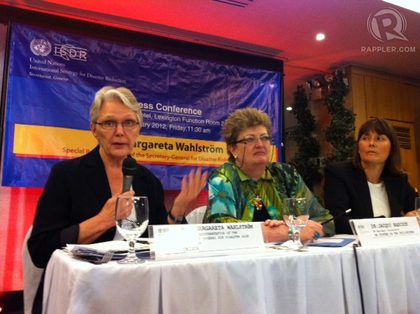SUMMARY
This is AI generated summarization, which may have errors. For context, always refer to the full article.
MANILA, Philippines – The Philippines topped the list of Asian countries hit by disasters in 2011, according to a recent report of the Center for Research on the Epidemiology of Disasters (CRED).
As a result, President Benigno Aquino III should prioritize disaster risk reduction.
This was according to Margareta Wahlström, Visiting Special Representative of the UN Secretary General for Disaster Risk Reduction, who said on Friday, January 27, she will tell the UN head to convey to the President the need to prioritize disaster risk reduction.
“I will ask him if he would kindly put it on his next agenda when he meets the President of the Philippines to highlight the opportunity to give top priority to reducing risk,” Wahlstrom told Rappler during her recent visit to the country.
The number of disasters that hit the country in 2011 totaled 33, claiming 1,430 lives. The figures are way higher than China’s 21, India’s 11, Indonesia’s 11, and Japan’s 7.
The country also topped the list of the highest number of people affected by calamities like floods, storms and earthquakes in 2011. There were 1,147,270 Filipinos adversely affected, according to the World Health Organization collaborating center, surpassing Japan’s 368,820.
Disasters cost the country P15 billion every year. Damages caused by tropical storm Sendong alone are estimated to amount to P1.3 billion (roughly $29.6 million).
Deadliest disaster
The deadliest disaster in 2011 remained to be earthquakes, followed by floods and storms. The CRED study showed that in Asia, 20,747 people lost their lives in earthquakes.
However, while storms used to be deadlier than floods between 2001-2010, data showed that floods claimed 3,243 lives as compared to storms (2,147) in 2011.
45% of the 302 disasters around the world happened in Asia last year, marking the continent as among the most vulnerable and worst affected. Over 80% of the 29,782 who were killed and 86% of the 205,841,038 who were affected by natural calamities were in Asia.
In terms of economic impact, Asia is also at the losing end as 75.1% of the total global figure on economic losses pegged at $365 billion were traced to the continent.

Gap on the ground
Wahlström noted that economic growth in areas vulnerable to disasters around the world could not keep pace with institutional capacity to manage resources and disaster risk reduction.
In her visit to Sendong-devastated Iligan and Cagayan de Oro, the UN official observed that many “municipalities lack practical experience on how to plan (for disaster risk reduction), how to prepare and how to keep it going.” This, she said, is the biggest gap on the ground.
Wahlström emphasized the need for the national government to guide local governments “because there is a collision of interests — economic development must be weighed against people’s safety.”
She stressed that because the country is disaster-prone, there is a need to address the gap even as it competes with other priorities.
“Let’s make sure that we are using the opportunities now to mitigate future impact. We have the resources and we have the partnerships, and let’s move along this agenda.”
At the frontline
The UN official applauded the Philippines for being at the frontline “in the thinking and execution of how to integrate the impact of climate variability” with overall disaster-risk reduction.
She said the UN hopes to work with the Philippines by supporting and monitoring the progress of the application of disaster risk reduction instruments to improve the resilience of disaster-prone communities in the country.
If she had the opportunity to meet President Aquino, the head of the UN disaster risk reduction office would have called for “the establishment of comprehensive land-use planning policies and more disaster-risk reduction investments to better protect communities against increasing and more severe climate-related hazards,” the United Nations International Strategy for Disaster Risk Reduction said in an advisory.
But because Aquino’s schedule “became too constrained” the meeting was not confirmed, Wahlström said. – Rappler.com
Add a comment
How does this make you feel?
There are no comments yet. Add your comment to start the conversation.